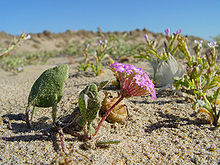키이드 니마곤
Kyide Nyimagon키이드 니마곤 (930년 죽음)[2] (티베탄: སྐྱིད་ཨིདེ་ཉི་མ་མགོན, Wylie: skyid ide nyi ma mgon, THL: kyi idé nyi ma gön; Chinese: 吉德尼玛衮; pinyin: jídé nímǎgǔn), whose original name was Khri-skyid-lding, was a member of the Yarlung dynasty of Tibet and a descendant of emperor Langdarma, who founded the kingdom of Ngari Khorsum ("the three divisions of Ngari")[3] in Western Tibet around 912 CE. 그가 죽은 후 그의 큰 왕국은 세 아들 사이에서 분열되어 마율(라다크), 구게푸랑, 잔스카르스피티 3국이 탄생하였다.
가족
랑다르마 황제가 암살된 후 티베트 제국은 랑다르마의 두 아들 염탄과 외성오즈드룽)의 계승 문제로 내전기에 돌입하여 제국을 두 부분으로 나누었다.[3][4] 외성의 아들 데팔 코르트센(870–c.910)c.[5]은 티베트 중부 대부분 또는 일부를 지배한 것으로 추정된다.[6]
팔기곤은 데팔 코르츠센의 아들 중 한 명이고, 다른 한 명은 트라시 첸(bKraśis-brtsegs-brtsan)이다.[1] 두 아들 모두 910년 아버지가 살해당하자 티베트 분쇄기의 시작을 기념하기 위해 취해진 UI-Tsang의 3차 반란 말기에 UI-Tsang (중부 티베트)에서 도망쳤다.
군림하다
나이마곤은 912년경 또는 그 무렵에 나르기(서 티베트)에 왕국을 세웠다. 그는 푸랑과 게의 왕국을 합병했다. 그 후 그는 게에 수도를 세웠다.
중-티베탄 문화는 오랫동안 이 지역에 존재했던 현재의 라다크에서 브로크파와 몬스의 문화를 대체하게 되었다.[2]
계승
그는 라첸 팔기공(티베탄: དཔལགི,,,,,,,,,,, Willie: dpal gyi mgon), 그의 장남인 마율 왕국(현재의 라다크)을 주었다.[7] His other two sons, Tashigön (Tibetan: བཀྲ་སིས་མགོན, Wylie: bkra sis mgon), and Detsukgön (Tibetan: ལྡེ་གཙུག་མགོན, Wylie: lde gtsug mgon) received respectively Guge-Purang and Zanskar. 이 세 나라는 함께 난가리 코르섬[8][7]이라고 불렸다.
그는 930년경에 죽었다.[2]
967년 그에게서 물려받은 타시공의 아들 예시외(Yeshe-EEW) 라마킹은 975년 퇴위하고 수도승 생활에 전념했다.[9]
참조
- ^ Jump up to: a b 페텍 1977, 페이지 15.
- ^ Jump up to: a b c 하사 2001, 페이지 128.
- ^ Jump up to: a b 랴베크 2015, 페이지 70.
- ^ Schlichtmann, Klaus (2016), A Peace History of India: From Ashoka Maurya to Mahatma Gandhi, Vij Books India Pvt Ltd, p. 108, ISBN 978-93-85563-52-2
- ^ 맥케이 2003, 페이지 57.
- ^ Petech 1977, 페이지 14-15.
- ^ Jump up to: a b 프랑케 1992년 페이지 94.
- ^ 피셔, 로즈 & 허튼백 1963, 페이지 19.
- ^ 하사 2001, 페이지 209.
참고 문헌 목록
- Di Mattia, Marialaura (Summer 1996), "Historical Profile of Ladakhi Religious Architecture", The Tibet Journal, Library of Tibetan Works and Archives, 21 (2, Shaping the Mind: Artistic Facets of Tibetan Civilization): 90–127
- Fisher, Margaret W.; Rose, Leo E.; Huttenback, Robert A. (1963), Himalayan Battleground: Sino-Indian Rivalry in Ladakh, Praeger, doi:10.2307/40199339, hdl:2027/mdp.39015010426792
- Francke, August Hermann (1992) [1926], Antiquities of Indian Tibet, 38, Volume 50 of New imperial series, Asian Educational Services, p. 94, ISBN 81-206-0769-4
- Francke, August Hermann (1907), A History of Western Tibet: One of the Unknown Empires, London: S.W. Partridge & Co
- Jahoda, Christian; Kalantari, Christiane (2015), "Kingship in Western Tibet in the 10th and 11th Centuries", Cahiers d'Extrême-Asie, École française d’Extrême-Orient, 24: 77–104
- Hāṇḍā, Om Chanda (2001), Buddhist Western Himalaya: A Politico-Religious History, New Dehli: Indus Publishing, ISBN 978-81-7387-124-5
- McKay, Alex (2003), The History of Tibet, RoutledgeCurzon, ISBN 9780415308427
- Petech, Luciano (1977), The Kingdom of Ladakh, c. 950–1842 A.D. (PDF), Instituto Italiano Per il Medio ed Estremo Oriente – via academia.edu
- Ryavec, Karl E. (2015), A Historical Atlas of Tibet, University of Chicago Press, ISBN 978-0-226-24394-8



